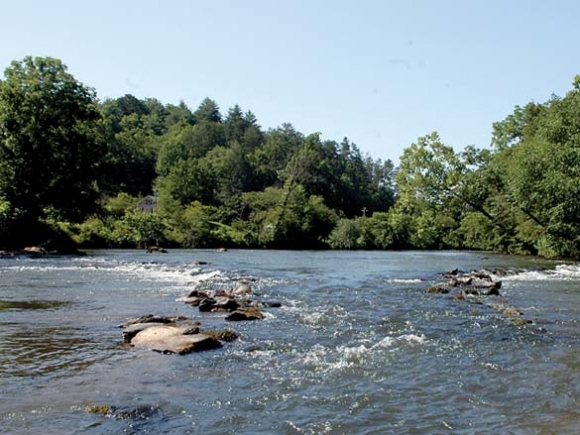Cherokee used toxins to stun fish

People sometimes wonder if the prehistoric Cherokees used any sort of poisons on their blowgun darts. These darts (slivers of black locust, hickory, or white oak) were from 10 to 20 inches long with thistledown tied at one end to form an air seal in the blowgun (a hollowed piece of cane cut to a length of seven to nine feet). The Cherokees were accurate with these weapons up to 40 or 60 feet, especially when shooting birds, but there is no evidence they used poisons of any sort on their darts.
They did, however, routinely employ poisons from several native plants when fishing. The drugging of fish was practiced during the dry months of late summer and early fall when water flow in mountain streams is often low, thereby creating a series of small pools with high concentrations of fish.
The two plants commonly used to stupefy fish were yellow buckeye (Aesculus octandra) and goat’s rue (Tephrosia virginica), which is also known as devil’s shoestrings or catgut.
Buckeye nuts were ground up and thrown into the pools of water. The poison thereby released was aesculin. This toxin caused the fish to float to the surface where they were easily collected in long-handled baskets made for that purpose. I do not know if the aesculin posed a risk to humans eating the fish.
Goat’s rue is still common in open or waste areas throughout the old Cherokee country. Easily recognized as a member of the Pea Family by its pinnate leaves that bear 17-29 leaflets, the silky-hairy plant (1-2 feet high) displays bi-colored, irregularly-shaped flowers (yellow base, pink wings) throughout the summer.
The Cherokees and other Indian tribes in the southeastern United States collected goat’s rue and ground it up on posts resting on the bottom of a pool. Shortly after the ground plant fell into the water, paralyzed fish would float to the surface for collection. The toxic substance in goat’s rue is rotenone, which is the principal ingredient in various insecticides and modern fish poisons. By attacking the nervous system of the fish, rotenone did not poison the meat in any way.
Related Items
The prehistoric Cherokees also speared fish, caught them with lines and bone hooks, shot them with bows and arrows, and grabbed them with their bare hands. But their most productive tactic involved the use of the rock weirs and fishtraps. Situated throughout the southern mountain region wherever the Cherokees located their large villages alongside major streams, these devices allowed for huge quantities of fish to be taken at one time.
Weirs were constructed where the water was swift. Two converging, wall-like alignments formed a V-shape. Facing downstream, the V-shaped structure funneled fish into a wicker or log trap. Harvesting the fish swept into the traps was a piece of cake.
When the catch was heavy, “they make a town feast, or feast of love, of which everyone partakes in a most social manner, and afterwards they dance together,” noted the 18th century Cherokee trader and historian James Adair.
The Cherokees especially liked to catch freshwater catfish, which could be cleaned but not skinned and smoked over a fire. The smoked and dried catfish provided valuable protein during the winter months.
The white settlers who replaced the Cherokees were not so foolish as to let the productive fish traps go to waste. They sometimes built their own, but for the most part they used those that their predecessors had constructed.
One of the most accessible of these ancient rock weirs is located alongside NC 28 about five miles north of Franklin across from the Cowee Gift Shop. Back in the late 1980s I visited with Robert T. Bryson to discuss this trap. He was then 83 years of age, having been born in the Cowee community in 1904.
Consulting the family Bible in which information had been recorded for generations, Mr. Bryson recalled that his ancestors came into the Little Tennessee region in the 1820s and began using the trap at that time.
“My father and I were still gathering fish from the 65-yard wide trap on up until 1920,” he said, while adding: “For the Cherokees it was a community project. Each family would contribute so many days working on the trap and share in the harvest. They constructed their trap at the mouth of the V-shaped opening by sinking huge locust logs to make a shute. Then four or five layers of white oak sticks, like tobacco sticks, would be laid down so that the fish would roll under them and get trapped.
“The water was always high back when I was a boy. Dad and I would take a boat out to check the trap. Mainly we’d catch fish in the spring when they were running. We caught a lot. Grandmother would sometimes try to dry the surplus, but mainly we shared them with the neighbors.
“One day Dad and I caught a fish whose tail still touched the ground when he held it up at eye level. It may have been a catfish. That’s the truth, not a fish story.”
(George Ellison is a naturalist and writer. He can be reached at This email address is being protected from spambots. You need JavaScript enabled to view it..)









